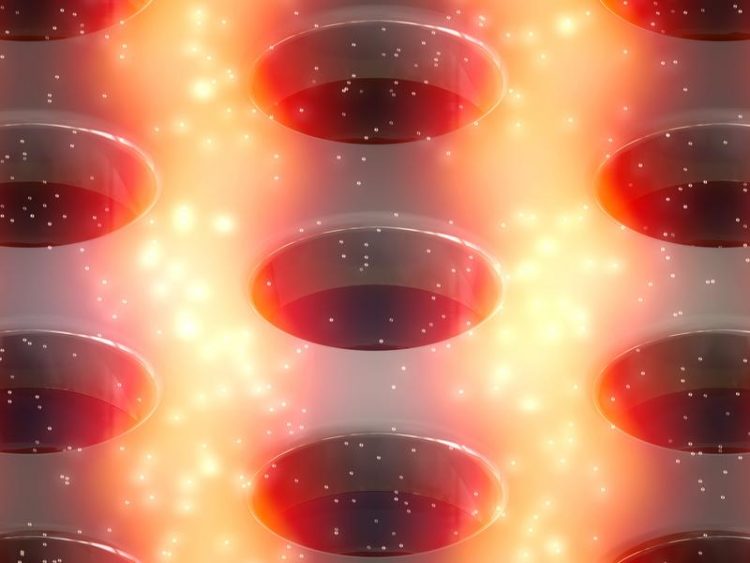Machine learning helps improving photonic applications

Here, stripes with local field maxima are formed, so that quantum dots shine particularly strongly. Carlo Barth / HZB
Nanostructures can increase the sensitivity of optical sensors enormously – provided that the geometry meets certain conditions and matches the wavelength of the incident light. This is because the electromagnetic field of light can be greatly amplified or reduced by the local nanostructure.
The HZB Young Investigator Group “Nano-SIPPE” headed by Prof. Christiane Becker is working to develop these kinds of nanostructures. Computer simulations are an important tool for this. Dr. Carlo Barth from the Nano-SIPPE team has now identified the most important patterns of field distribution in a nanostructure using machine learning, and has thereby explained the experimental findings very well for the first time.
Quantum dots on nanostructures
The photonic nanostructures examined in this paper consist of a silicon layer with a regular hole pattern coated with what are referred to as quantum dots made of lead sulphide. Excited with a laser, the quantum dots close to local field amplifications emit much more light than on an unordered surface. This makes it possible to empirically demonstrate how the laser light interacts with the nanostructure.
Ten different patterns discovered by machine learning
In order to systematically record what happens when individual parameters of the nanostructure change, Barth calculates the three-dimensional electric field distribution for each parameter set using software developed at the Zuse Institute Berlin. Barth then had these enormous amounts of data analyzed by other computer programs based on machine learning.
“The computer has searched through the approximately 45,000 data records and grouped them into about ten different patterns”, he explains. Finally, Barth and Becker succeeded in identifying three basic patterns among them in which the fields are amplified in various specific areas of the nanoholes.
Outlook: Detection of single molecules, e.g. cancer markers
This allows photonic crystal membranes based on excitation amplification to be optimised for virtually any application. This is because some biomolecules accumulate preferentially along the hole edges, for example, while others prefer the plateaus between the holes, depending on the application.
With the correct geometry and the right excitation by light, the maximum electric field amplification can be generated exactly at the attachment sites of the desired molecules. This would increase the sensitivity of optical sensors for cancer markers to the level of individual molecules, for example.
The software used as well as the data can be downloaded free.
Published in Communications Physics (2018). “Machine learning classification for field distributions of photonic modes”, Carlo Barth & Christiane Becker
DOI:10.1038/s42005-018-0060-1
Media Contact
All latest news from the category: Life Sciences and Chemistry
Articles and reports from the Life Sciences and chemistry area deal with applied and basic research into modern biology, chemistry and human medicine.
Valuable information can be found on a range of life sciences fields including bacteriology, biochemistry, bionics, bioinformatics, biophysics, biotechnology, genetics, geobotany, human biology, marine biology, microbiology, molecular biology, cellular biology, zoology, bioinorganic chemistry, microchemistry and environmental chemistry.
Newest articles

Superradiant atoms could push the boundaries of how precisely time can be measured
Superradiant atoms can help us measure time more precisely than ever. In a new study, researchers from the University of Copenhagen present a new method for measuring the time interval,…

Ion thermoelectric conversion devices for near room temperature
The electrode sheet of the thermoelectric device consists of ionic hydrogel, which is sandwiched between the electrodes to form, and the Prussian blue on the electrode undergoes a redox reaction…

Zap Energy achieves 37-million-degree temperatures in a compact device
New publication reports record electron temperatures for a small-scale, sheared-flow-stabilized Z-pinch fusion device. In the nine decades since humans first produced fusion reactions, only a few fusion technologies have demonstrated…





















